Liang Chen
Utsunomiya University, Japan
Mitigating Overthinking through Reasoning Shaping
Oct 10, 2025Abstract:Large reasoning models (LRMs) boosted by Reinforcement Learning from Verifier Reward (RLVR) have shown great power in problem solving, yet they often cause overthinking: excessive, meandering reasoning that inflates computational cost. Prior designs of penalization in RLVR manage to reduce token consumption while often harming model performance, which arises from the oversimplicity of token-level supervision. In this paper, we argue that the granularity of supervision plays a crucial role in balancing efficiency and accuracy, and propose Group Relative Segment Penalization (GRSP), a step-level method to regularize reasoning. Since preliminary analyses show that reasoning segments are strongly correlated with token consumption and model performance, we design a length-aware weighting mechanism across segment clusters. Extensive experiments demonstrate that GRSP achieves superior token efficiency without heavily compromising accuracy, especially the advantages with harder problems. Moreover, GRSP stabilizes RL training and scales effectively across model sizes.
Beyond Two-Stage Training: Cooperative SFT and RL for LLM Reasoning
Sep 08, 2025Abstract:Reinforcement learning (RL) has proven effective in incentivizing the reasoning abilities of large language models (LLMs), but suffers from severe efficiency challenges due to its trial-and-error nature. While the common practice employs supervised fine-tuning (SFT) as a warm-up stage for RL, this decoupled two-stage approach limits interaction between SFT and RL, thereby constraining overall effectiveness. This study introduces a novel method for learning reasoning models that employs bilevel optimization to facilitate better cooperation between these training paradigms. By conditioning the SFT objective on the optimal RL policy, our approach enables SFT to meta-learn how to guide RL's optimization process. During training, the lower level performs RL updates while simultaneously receiving SFT supervision, and the upper level explicitly maximizes the cooperative gain-the performance advantage of joint SFT-RL training over RL alone. Empirical evaluations on five reasoning benchmarks demonstrate that our method consistently outperforms baselines and achieves a better balance between effectiveness and efficiency.
ROD: RGB-Only Fast and Efficient Off-road Freespace Detection
Aug 12, 2025



Abstract:Off-road freespace detection is more challenging than on-road scenarios because of the blurred boundaries of traversable areas. Previous state-of-the-art (SOTA) methods employ multi-modal fusion of RGB images and LiDAR data. However, due to the significant increase in inference time when calculating surface normal maps from LiDAR data, multi-modal methods are not suitable for real-time applications, particularly in real-world scenarios where higher FPS is required compared to slow navigation. This paper presents a novel RGB-only approach for off-road freespace detection, named ROD, eliminating the reliance on LiDAR data and its computational demands. Specifically, we utilize a pre-trained Vision Transformer (ViT) to extract rich features from RGB images. Additionally, we design a lightweight yet efficient decoder, which together improve both precision and inference speed. ROD establishes a new SOTA on ORFD and RELLIS-3D datasets, as well as an inference speed of 50 FPS, significantly outperforming prior models.
What Matters in LLM-generated Data: Diversity and Its Effect on Model Fine-Tuning
Jun 24, 2025
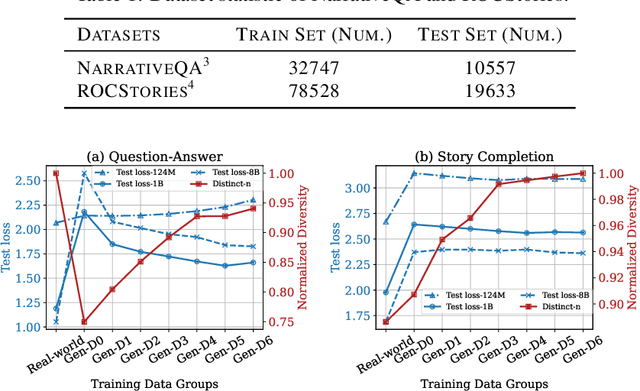
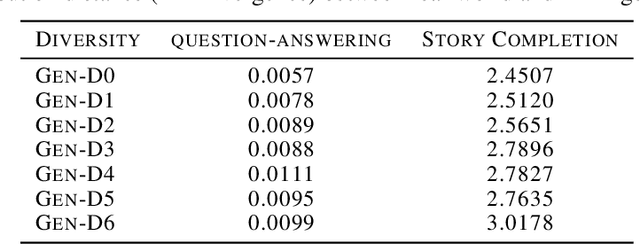

Abstract:With the remarkable generative capabilities of large language models (LLMs), using LLM-generated data to train downstream models has emerged as a promising approach to mitigate data scarcity in specific domains and reduce time-consuming annotations. However, recent studies have highlighted a critical issue: iterative training on self-generated data results in model collapse, where model performance degrades over time. Despite extensive research on the implications of LLM-generated data, these works often neglect the importance of data diversity, a key factor in data quality. In this work, we aim to understand the implications of the diversity of LLM-generated data on downstream model performance. Specifically, we explore how varying levels of diversity in LLM-generated data affect downstream model performance. Additionally, we investigate the performance of models trained on data that mixes different proportions of LLM-generated data, which we refer to as synthetic data. Our experimental results show that, with minimal distribution shift, moderately diverse LLM-generated data can enhance model performance in scenarios with insufficient labeled data, whereas highly diverse generated data has a negative impact. We hope our empirical findings will offer valuable guidance for future studies on LLMs as data generators.
Vulnerability-Aware Alignment: Mitigating Uneven Forgetting in Harmful Fine-Tuning
Jun 04, 2025Abstract:Harmful fine-tuning (HFT), performed directly on open-source LLMs or through Fine-tuning-as-a-Service, breaks safety alignment and poses significant threats. Existing methods aim to mitigate HFT risks by learning robust representation on alignment data or making harmful data unlearnable, but they treat each data sample equally, leaving data vulnerability patterns understudied. In this work, we reveal that certain subsets of alignment data are consistently more prone to forgetting during HFT across different fine-tuning tasks. Inspired by these findings, we propose Vulnerability-Aware Alignment (VAA), which estimates data vulnerability, partitions data into "vulnerable" and "invulnerable" groups, and encourages balanced learning using a group distributionally robust optimization (Group DRO) framework. Specifically, VAA learns an adversarial sampler that samples examples from the currently underperforming group and then applies group-dependent adversarial perturbations to the data during training, aiming to encourage a balanced learning process across groups. Experiments across four fine-tuning tasks demonstrate that VAA significantly reduces harmful scores while preserving downstream task performance, outperforming state-of-the-art baselines.
Hadaptive-Net: Efficient Vision Models via Adaptive Cross-Hadamard Synergy
May 28, 2025Abstract:Recent studies have revealed the immense potential of Hadamard product in enhancing network representational capacity and dimensional compression. However, despite its theoretical promise, this technique has not been systematically explored or effectively applied in practice, leaving its full capabilities underdeveloped. In this work, we first analyze and identify the advantages of Hadamard product over standard convolutional operations in cross-channel interaction and channel expansion. Building upon these insights, we propose a computationally efficient module: Adaptive Cross-Hadamard (ACH), which leverages adaptive cross-channel Hadamard products for high-dimensional channel expansion. Furthermore, we introduce Hadaptive-Net (Hadamard Adaptive Network), a lightweight network backbone for visual tasks, which is demonstrated through experiments that it achieves an unprecedented balance between inference speed and accuracy through our proposed module.
G1: Bootstrapping Perception and Reasoning Abilities of Vision-Language Model via Reinforcement Learning
May 19, 2025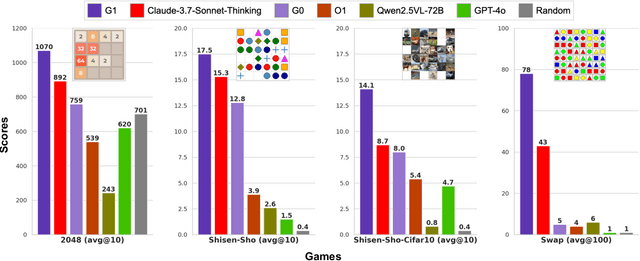


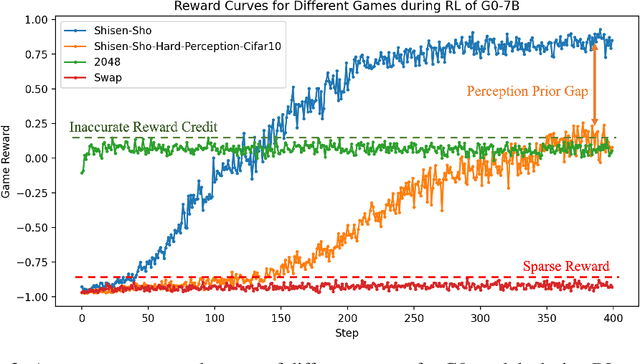
Abstract:Vision-Language Models (VLMs) excel in many direct multimodal tasks but struggle to translate this prowess into effective decision-making within interactive, visually rich environments like games. This ``knowing-doing'' gap significantly limits their potential as autonomous agents, as leading VLMs often performing badly in simple games. To address this, we introduce VLM-Gym, a curated reinforcement learning (RL) environment featuring diverse visual games with unified interfaces and adjustable, compositional difficulty, specifically designed for scalable multi-game parallel training. Leveraging VLM-Gym, we train G0 models using pure RL-driven self-evolution, which demonstrate emergent perception and reasoning patterns. To further mitigate challenges arising from game diversity, we develop G1 models. G1 incorporates a perception-enhanced cold start prior to RL fine-tuning. Our resulting G1 models consistently surpass their teacher across all games and outperform leading proprietary models like Claude-3.7-Sonnet-Thinking. Systematic analysis reveals an intriguing finding: perception and reasoning abilities mutually bootstrap each other throughout the RL training process. Source code including VLM-Gym and RL training are released at https://github.com/chenllliang/G1 to foster future research in advancing VLMs as capable interactive agents.
Style-Adaptive Detection Transformer for Single-Source Domain Generalized Object Detection
Apr 29, 2025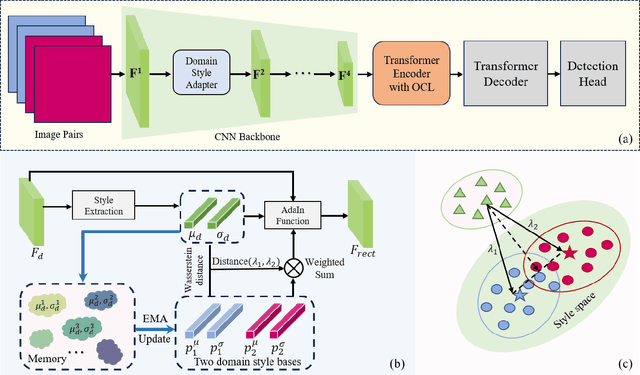
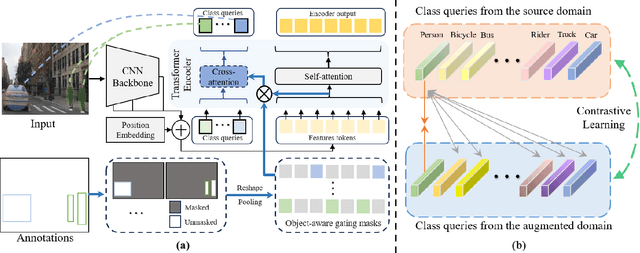
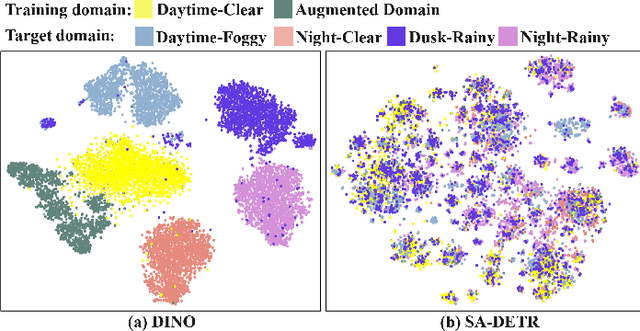
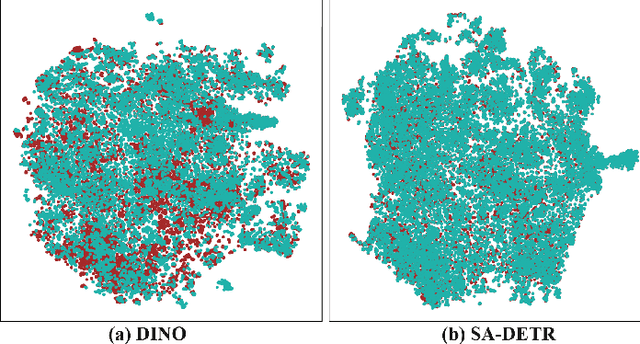
Abstract:Single-source Domain Generalization (SDG) in object detection aims to develop a detector using only data from a source domain that can exhibit strong generalization capability when applied to unseen target domains. Existing methods are built upon CNN-based detectors and primarily improve robustness by employing carefully designed data augmentation strategies integrated with feature alignment techniques. However, data augmentation methods have inherent drawbacks; they are only effective when the augmented sample distribution approximates or covers the unseen scenarios, thus failing to enhance generalization across all unseen domains. Furthermore, while the recent Detection Transformer (DETR) has demonstrated superior generalization capability in domain adaptation tasks due to its efficient global information extraction, its potential in SDG tasks remains unexplored. To this end, we introduce a strong DETR-based detector named the Style-Adaptive Detection Transformer (SA-DETR) for SDG in object detection. Specifically, we present a domain style adapter that projects the style representation of the unseen target domain into the training domain, enabling dynamic style adaptation. Then, we propose an object-aware contrastive learning module to guide the detector in extracting domain-invariant features through contrastive learning. By using object-aware gating masks to constrain feature aggregation in both spatial and semantic dimensions, this module achieves cross-domain contrast of instance-level features, thereby enhancing generalization. Extensive experiments demonstrate the superior performance and generalization capability of SA-DETR across five different weather scenarios. Code is released at https://github.com/h751410234/SA-DETR.
GT-SVQ: A Linear-Time Graph Transformer for Node Classification Using Spiking Vector Quantization
Apr 16, 2025Abstract:Graph Transformers (GTs), which simultaneously integrate message-passing and self-attention mechanisms, have achieved promising empirical results in some graph prediction tasks. Although these approaches show the potential of Transformers in capturing long-range graph topology information, issues concerning the quadratic complexity and high computing energy consumption severely limit the scalability of GTs on large-scale graphs. Recently, as brain-inspired neural networks, Spiking Neural Networks (SNNs), facilitate the development of graph representation learning methods with lower computational and storage overhead through the unique event-driven spiking neurons. Inspired by these characteristics, we propose a linear-time Graph Transformer using Spiking Vector Quantization (GT-SVQ) for node classification. GT-SVQ reconstructs codebooks based on rate coding outputs from spiking neurons, and injects the codebooks into self-attention blocks to aggregate global information in linear complexity. Besides, spiking vector quantization effectively alleviates codebook collapse and the reliance on complex machinery (distance measure, auxiliary loss, etc.) present in previous vector quantization-based graph learning methods. In experiments, we compare GT-SVQ with other state-of-the-art baselines on node classification datasets ranging from small to large. Experimental results show that GT-SVQ has achieved competitive performances on most datasets while maintaining up to 130x faster inference speed compared to other GTs.
Kimi-VL Technical Report
Apr 10, 2025

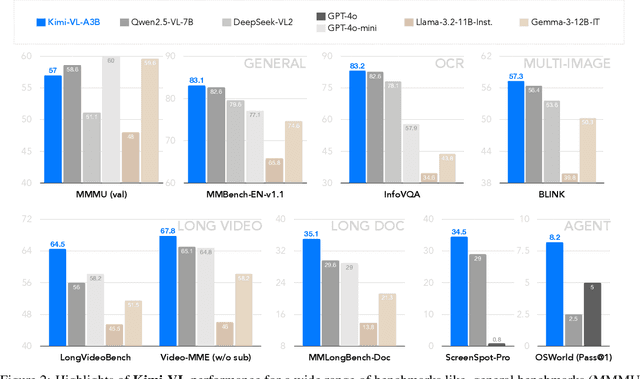

Abstract:We present Kimi-VL, an efficient open-source Mixture-of-Experts (MoE) vision-language model (VLM) that offers advanced multimodal reasoning, long-context understanding, and strong agent capabilities - all while activating only 2.8B parameters in its language decoder (Kimi-VL-A3B). Kimi-VL demonstrates strong performance across challenging domains: as a general-purpose VLM, Kimi-VL excels in multi-turn agent tasks (e.g., OSWorld), matching flagship models. Furthermore, it exhibits remarkable capabilities across diverse challenging vision language tasks, including college-level image and video comprehension, OCR, mathematical reasoning, and multi-image understanding. In comparative evaluations, it effectively competes with cutting-edge efficient VLMs such as GPT-4o-mini, Qwen2.5-VL-7B, and Gemma-3-12B-IT, while surpassing GPT-4o in several key domains. Kimi-VL also advances in processing long contexts and perceiving clearly. With a 128K extended context window, Kimi-VL can process diverse long inputs, achieving impressive scores of 64.5 on LongVideoBench and 35.1 on MMLongBench-Doc. Its native-resolution vision encoder, MoonViT, further allows it to see and understand ultra-high-resolution visual inputs, achieving 83.2 on InfoVQA and 34.5 on ScreenSpot-Pro, while maintaining lower computational cost for common tasks. Building upon Kimi-VL, we introduce an advanced long-thinking variant: Kimi-VL-Thinking. Developed through long chain-of-thought (CoT) supervised fine-tuning (SFT) and reinforcement learning (RL), this model exhibits strong long-horizon reasoning capabilities. It achieves scores of 61.7 on MMMU, 36.8 on MathVision, and 71.3 on MathVista while maintaining the compact 2.8B activated LLM parameters, setting a new standard for efficient multimodal thinking models. Code and models are publicly accessible at https://github.com/MoonshotAI/Kimi-VL.
 Add to Chrome
Add to Chrome Add to Firefox
Add to Firefox Add to Edge
Add to Edge